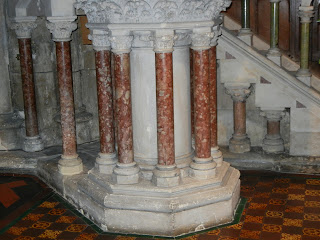 St. Stephen's Green is a beautiful, serene 22 acre park in the heart of Dublin. It is the largest garden green in Europe.
St. Stephen's Green is a beautiful, serene 22 acre park in the heart of Dublin. It is the largest garden green in Europe.

The day that these pictures in the park were taken it was actually sunny and hot by Ireland's standards. The temps were in the low 70s and everyone came to the park. There were a number of businessmen like the guys in this picture that took a break from the office. One thing that we did observe was that no one was on their laptop, smartphone, or tablet. Even people that were there alone were sitting quietly, reading, or napping. People were there to enjoy the weather and each other's company. It was a bit different than a day in the park in the U.S..
 |
| Another entrance/exit from the park at dusk located across the street from the Grafton shopping district |
 |
| St. Ann's Church on Dawson Street in Dublin, Ireland, was built in the early 18th century following the establishment of the local Anglican parish in 1707. The building of the church in baroque style commenced in 1720, to a design by Isaac Wills.[2] The current façade dates to the 19th century. In 1907, St. Ann's was listed as one of just six Dublin church buildings surviving from the 18th century.[3][4][5] |
 |
A fashion magazine that came with the Irish Time newspaper one day. What I took from this cover is that Opie would've been a raging sensation in the Ireland modeling circuit.
|
Saint Patrick's Cathedral is Ireland's largest church. The original building established around AD 450 was just a wooden chapel. In 1192, it was rebuilt in stone. Much of the present building dates back to work done during the mid 13th century although it underwent extensive restoration in the 1860s.
This is the stone slab that covered the sacred well that St. Patrick used to baptize converts around AD 450. It was unearthed at the turn of the 20th century. The church was erected beside the well.
 |
| This elaborate tomb was dedicated to the Boyle family in the 17th century. Richard Boyle, Earl of Cork, erected it in memory of his second wife Katherine. |
 |
| A sample of the intricate tile work in the floor of the church. The entire floor of the church was comprised of similar patterns and complex designs. |
 |
| Jonathan Swift's corner. He bacame Dean of St. Patrick's in 1713. He's buried in the chapel. |
 |
| This is a bust of Jonathan Swift. He was born and raised in Dublin and educated at Trinity College. He was a writer whose best known work was Gulliver's Travels. Swift was a bit of a maverick in his day. He wrote political commentaries and bitter satires and drew criticism for his relationships with two younger women, Stella and Hester. |
 |
| This is the pulpit that Dean Swift used to give his sermons. His sermons would drone on for hours which caused some of the parishioners to fall asleep. As a result, he had the base outfitted with wheels so that he could be pushed through the cathedral and whack with a stick any unsuspecting parishioners that he caught napping during his sermon. |
 |
| This is the present day pulpit. The detailed carving and ornate design is pretty spectacular. |
 |
| Marble and stone pillars at the base of the pulpit |

 |
| This pew box was reserved for dignitaries and high ranking officials. |
 |
| Church pews for the parishioners. Functional but not at all comfortable. |
 |
| I think these were cushions for the pews. If so, they were sorely needed. Every chair had one hanging off the back of the chair and most of the designs looked unique. |
 |
| Ornate iron vent grills. Again, note the intricate and elaborate tile work on the floor. There were a number of these radiators, but I can't imagine they could adequately heat this massive church and it's soaring ceilings. |
 |
| This figurehead is carved into a pillar in the church. He's called the green man and is the only one like it in the cathedral. The detail in his face (eyes, teeth, and nose) are worth noting. |
 |
| Built in 1701, this is the oldest public library in Ireland. It's located behind St. Patrick's cathedral. |
 |
| An old guard house at the Dublin castle |
Trinity College (Irish: Coláiste na Tríonóide), officially the College of the Holy and Undivided Trinity of Queen Elizabeth near Dublin, is the sole constituent college of the University of Dublin, a research university in Dublin, Ireland.[10] Queen Elizabeth I founded the college in 1592 as "the mother of a university" that was modeled after the collegiate universities of Oxford and Cambridge, but unlike these affiliated institutions, only one college was ever established; as such, the designations "Trinity College" and "University of Dublin" are usually synonymous for practical purposes.[11]
 |
| Trinity College founded in 1592 |
 |
It is one of the seven ancient universities of Britain and Ireland,[16] as well as Ireland's oldest surviving university.[17] The university's main campus, in the heart of Dublin, has been ranked among the most iconic in the world, and is the setting for a number of novels, films and urban legends.[18][19][20] Widely considered one of Europe's elite universities, Trinity is Ireland's most prestigious university, in part due to its historical significance.[21][22] |
 |
| The Campanile bell tower in the parliament square on campus |


















































No comments:
Post a Comment